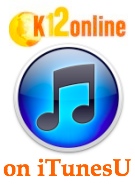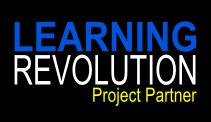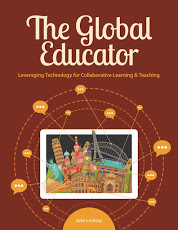Alan Levine Scottsdale, Arizona, USA
Blog: http://cogdogblog.com
Bio Alan Levine is Vice President, Community and CTO for the New Media Consortium (NMC), an international consortium of more than 250 world-class universities, colleges, museums, research centers, and technology companies dedicated to using new technologies to inspire, energize, stimulate, and support learning and creative expression He is widely recognized nationally and internationally for expertise in the application of new technologies to educational environments and was a pioneer on the web going back to 1993. He has taken the dog theme to excess, appearing as one in Second Life, and will be circumnavigating Australia (not chasing dingoes) during the time of this conference.
Bio Page http://cogdogblog.com/about/
Twitter: @cogdog
Brian Lamb Vancouver, British Columbia, Canada
Blog: http://weblogs.elearning.ubc.ca/brian/
Bio Brian Lamb is Manager, Emerging Technologies and Digital Content with the Office of Learning Technology at The University of British Columbia. He teaches a course on “Text Technologies” for UBC’s Master of Educational Technology Program. He is also a Research Fellow with Utah State University’s Center for Open and Sustainable Learning. Brian maintains his weblog Abject Learning http://weblogs.elearning.ubc.ca/brian/, where he mutters ll-tempered observations on social learning, open education, disruptive technologies and other such things.
Bio Page http://careo.elearning.ubc.ca/cgi-bin/wiki.pl?Brian_Lamb
Twitter: @brlamb
D’Arcy Norman Calgary, Alberta, Canada
Blog: http://www.darcynorman.net
Bio D’Arcy is an educational technology developer at the Teaching and Learning Centre, at The University of Calgary. He has been playing with educational technology in one form or another since the early days of the Vic20, and currently spends much of his professional time developing content and crafting tools for faculty and students to use to support their practices of teaching and learning.
Bio Page http://www.darcynorman.net/about/
Twitter: @dlnorman
Presentation Title “More Than Cool Tools”
Description There is no shortage of “Cool New Web Tools” out there and all three of us are guilty as charged for presenting them to teachers via the firehose effect. In our session, we will begin with a nostalgic nod to our presentation past where just 3 years ago we were talking up “Small Pieces Loosely Joined” – blogs, wikis, and a little RSS. Now there is so much more, almost too much. So we may talk about some cool tools, but more at a level of looking at the affordances which make them compelling, and why these and future breeds of tools and platforms matter to K12 teachers.
iPod ready http://k12online.wm.edu/K12Online_MoreThanCoolTools_ipod.mp4 (53:45 Run Time; mpeg4, 71.8MB)
Originalhttp://k12online.wm.edu/K12Online_MoreThanCoolTools_full.mov (53:45 Run Time; mov, 415.2 MB)
Audio onlyhttp://k12online.wm.edu/K12Online_MoreThanCoolTools_full.mp3 (53:35 Run Time; mp3, 6.2 MB)
Supporting Links http://morethancooltools.wikispaces.com/
What is “Take My Hand”?“Take My Hand” Access Help Desk [tags]k12online07nt01, k12online07[/tags]








Your mp3 feed is truncated. I’d really like to listen to these guys. Any chance of getting the full audio version posted?
We are on it James! The Mp3 for both keynotes will be reloaded soon. Please check back. We will send a message in Twitter when that has been accomplished.
Thanks!
There’s also a (lower quality) streaming version of the file on Google Video at:
http://video.google.com/videoplay?docid=6051532175991528523&hl=en
One technical question- Waht do you use to capture moves on the screen /activity while working on the PC ?
Is there any free stuff available?
Tried posting this morning, but the comment got eaten… There’s a Google Video version of the presentation available at http://video.google.ca/videoplay?docid=6051532175991528523&hl=en-CA
And for the screencasts, I used iShowU on MacOSX – I’m not sure what Brian used for his part…
Alicia, a nice free screencapture tool is: Wink: http://www.debugmode.com/wink/
or try this web 2.0 screencast creation site:
http://www.screencast-o-matic.com/
If your school district has a Smart Board in it, you can download and use the Smart Recorder for free.
I posted about this in web time “eons” ago.
http://www.teachinghacks.com/2005/02/09/screencasting-on-a-budget/
Also see Windows Media Encoder- http://www.microsoft.com/windows/windowsmedia/9series/encoder/default.aspx
And CamStudio 2.0 http://www.swftools.com/tools-details.php?tool=8162413051
This took quite a while to download, but the wait was worth it.
I thought the ideas about how to add content to one place and then use it another was eyeopening to me. I would very much like to use many of these storytelling venues in my science classroom.
I’ve been trying to teach myself how to blend images from one place into Google Earth. I think this presentation gave me some good leads on how to go about it. Gosh I wish there was more than 24 hours in a day, so I’d have time to do the work.
I know…let the students lead the way. Thanks for some neat ideas.
Vinne Vrotny just recently blogged about Jing for making screencasts:
http://miningfortreasures.edublogs.org/2007/10/01/creating-tutorials-using-jing/
Thanks for making me look at and reflect upon the broader picture of Web 2.0.
Brilliant piece, well worth spending the time viewing this. I have so many more tags on my del.icio.us page!
Passwords – in Queensland consent schedules and passwords are the norm. No photos which identify the children allowed either. Restricts those who want to innovate. Main issue though is internet access. A number of teachers and children do not have broadband internet access so not inclined to spend time waiting for dial up downloads. This is a semi rural area only 30 minutes from Brisbane!
This keynote was very motivating to me. I will spend a lot of time reviewing these tools over the course of this school year.
I have seen that Presentations with sound work quite well on Wiziq and authorstream. I read a Techchrunch article ( http://forums.techcrunch.com/forums/thread.jspa?threadID=5040 ) and tried it out. They say that animations, effects and sound are retained. I tried some and seemed to work every time. I have also seen that their embeds work in full screen as claimed in the article. Maybe you can try uploading your presentation there.
I missed the links in the previous comment so in case you are wondering, here are the URLs of the two services:
http://www.wiziq.com/
http://www.authorstream.com/
They also have a free tool called AuthorPoint lite — authorpointlite.com which you can use to batch upload or preview presentations before you upload to the services. You can upload straight from this tool after importing your presentations.
Hope this is helpful.
Thank you for a great introduction to the web2.0 world and the many resources associated with it. I look forward to sharing this presentation with my students.
I have a question about the slideshare resource mentioned in the presentation. Does anyone know of a “SlideShare” type site that allows for all of the hyperlinks and Kiosk in the PowerPoint to work properly? I have not been able to get my Kiosk and hyperlinks to work well on SlideShare, but I thought someone in this presentation might have a better resource.
Hey, guys, great job! By the way, where are the links to all these sites you have highlighted. I looked on your wiki on the “big Pile of Sites Page” but only saw 2 links. Am I missing something?
FANTASTIC presentation, amigos! Wow. I posted a 22 minute reflection and response to your session to my personal PD blog tonight using Gabcast. You all have REALLY given me some new vocabulary to use as well as inspiration for professional development with other teachers. GREAT work.
What I most appreciate about this presentation are the last five minutes in which you talk about the “disrupting” nature of these new tools. But you characterize that disruption as neither all good or all bad. It just IS, and we have to learn to be comfortable with that. Thanks for the great insights.
Liz, I see that image hyperlinks work in authorStream and Wiziq (read my previous comments in this post). Perhaps, wherever you want to highlight a site, you can just make an image of the url and hyperlink the image in PowerPoint. This should work I guess. Try it out.
Nicely done! Just when I was beginning to think I had a good grasp of all the good current free tools online they gave me a list to check out. They also did an elegant job of describing some of the the classics like flickr, digg, and delicious. I especially liked how they used the verbs: embed, connect, socialize, share, collaborate, remix, liberate, filter, and disrupt to define and describe the web2.0 phenomenon. An excellent introduction for educators to the new read write web.
Great presentation on tools. There were some great tools that I had not seen or heard of, but immediately checked out. I particularly like the sections on filters, and the pipes mashup. Thanks for all the helpful info.
After watching the video More Than Cool Tools, I’ve reflected on the Web 2.0 tools I’ve chosen to endorse in our district. In 2004 blogs, wikis, and RSS were available. In the Spring of 2007 blogs, wikis, and RSS were just taking off in my district. Partly because I’m not an early adopter when it comes to the tools I choose for the professional learning opportunities that I offer our staff. I see it as an investment when I create professional learning objects. I want to be sure it is truly beneficial in the classroom and not just a novelty. I don’t want to waste the teacher’s time, or “firehose” them with the ever increasing tools out there. I go to my learning network to see what tools others are using, and how they have successfully applied the tools to the classroom. Many of the verbs mentioned in this presentation are things I consider when selecting tools. As mentioned in the presentation, Web 2.0 tools come and go overnight, so I try to choose tools that have stood the test of time, which in the Internet world is not long, and still just a shot in the dark. I’m familiar with many of tools mentioned. Some of the tools I’m supporting in our District include Edublogs, Wikispaces, Bloglines, Flickr, Moodle, United Streaming, ePALs, Google Docs, Skype, Voice Thread, Picnik, Podomatic, Audacity, Feedburner, Delicious, SlideShare, BubbleShare, iTunes, and Creative Commons. I share all my learning objects online, licensed with Creative Commons, including Moodle professional development courses for our teachers, screencast tutorials, handouts, and online resources.Living in a constant construction zone is a phrase that I connected with from the session. The tools are constantly changing to meet the needs of users and include new features, which is good. This has caused me to reflect on the way I instruct and model the use of technology for teachers. When preparing, I visualize classroom application and the management issues that need to be addressed. I spend a lot of time creating how-to guides with specific, numbered steps. But these learning objects can become outdated in just days. I need to model how I learn new tools. Opportunities arise during workshops in which a teacher asks how to do something I haven’t tried yet, and I model then how to find the answer. Teachers need to be able to deal with the constant state of change of Web 2.0 tools. As David Warlick said in his keynote, one of the most important tasks we can complete as educators is to show our students how to be learners. I need to model more for the teachers the strategies I use when learning a new tool. Up to this point the purpose of my blog has been basically informational. I now see a reason for using it for reflecting on my own learning.
Simply Amazing! This was a fascinating look at the big picture. Your presentation added greatly to my knowledge and opened my mind to a new world of tools that are available. I also went to your wiki page and love the “Drafty Outline”. I took notes as I listened but found your outline to be a delightful resource.
I have only just recently learned about the K-12 Online Conference. Yours was the second presentation I listened to/watched. If this is the high standard to expect, I’m not sure when I will get any work done!!! Enjoyable, Entertaining and Educational – what a wonderful combination!
Thank you very much!
Great presentation, all. I really liked how you modeled pieces loosely joined. The frame of looking at key indicators like embedding, socialization, liberalization, and disruptiveness really tied all thoughts together.
I enjoyed the link to Alan’s 50 Ways to Tell a Story. What a wonderful resource! I would really like access to links of some of the tools in the keynote that aren’t in the 50 tools site. Might those be somewhere else, even tagged in del.icio.us?
Thanks for the great work.
Thanks “Three Amigos” Knowing about tools is only step one in actually using them. Thanks for the great introduction! With knowledge comes responsibility. Now, I have to explore ways to use these tools in my teaching and have my students use them in their learning.
Hey guys, what a great presentation. Thanks for providing a whole array of information I would have not seen had it been for you. I enjoyed watching the presentation and feel glad not giving up on it. It takes quiet a while for it to download and this is the third time I tried it and I’m glad it worked today. I learned many great pieces of information. For instance, the way technology and informatin are on the rise and are doubling in size in just a small amount of time. Anyhow, it makes me feel quite good when you mentioned some softward such as goodle docs that I already know how it works and have use it. But it makes me worry when you mention a tremendous number of software out there that I had not even heard about. I think the time is coming when I will no longer be able to keep up with all this information and will be left behing. All in all, a great presenation.
I can say only wow! So many tools!!
I like how the new tools were defined im a basic simple way so that teachers like me can understand what they are and how they can be used. I’ve heard the terms wiki, blog, rss, utube, slide share, voice tread, flicker and google docs before but couldn’t really keep the definitions straight nor explain it to someone. Listening to keynote speakers on line help me take notes and understand these new cool tools better. Thanks!
Great presentation Alan, Brian, and D’Arcy. Each of you brought new ideas to the presentation. I constantly found myself pausing the presentation to check out some of the resources mentioned.
I teach a course to pre-service elementary education students. I have moved my course materials off WebCT and into Wikispaces.
Now I’m off to learn more about DIGG. I’ve heard of it for a long time, but had not touched it. This presentation will be of great use for teachers in my building and students who take my course. Thanks for a great presentation!
I learned a lot from Alan, Brian and D’Arcy in this session; I will be referring back to it and using my notes to help me remember what is here. The first thing that struck me was that they were writing about RSS in 2003 and I really didn’t grasp the value or start using RSS until 2007. I could feel badly about that time lag, but as I work with educators in Southern Maine most are still unaware of the uses for RSS, or classroom blogs, wikis, personalized web pages, del.icio.us accounts, etc. The goal I have for this year is that each teacher will have and use all of those five tools for themselves and their students.
Pingback: Life-Long-Learners